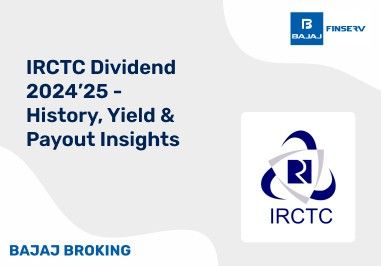BAJAJ BROKING
Tankup Engineers IPO is Open!
Open a Free Demat Account
Trade Now, Pay Later with up to 4x
Track Market Movers Instantly
What is EMA in Stocks?
There are many technical indicators that traders rely on to understand historical price patterns and predict future price movements. Some indicators work better in certain market conditions than others, and each indicator serves a specific purpose in the trader’s overall strategy. One such technical indicator that works in all market phases is the exponential moving average.
The use of terms like ‘exponential’ and ‘average’ may give beginners the misconception that it is a complicated indicator. However, it is quite easy to calculate and even easier to understand and interpret. In this article, we’ll take a closer look at how you can define EMA for stocks, calculate the EMA and interpret it.
What is EMA in Stocks?
EMA, also known as exponential moving average, is one of the most widely-used technical indicators. It is a weighted variant of the SMA or simple moving average that places more emphasis or weightage on the more recent price actions. This makes the indicator more responsive to changes in the price and trend of an asset compared to the simple moving average.
The exponential moving average can be calculated for different time frames. However, the shorter the period, the more weightage the indicator gives to the recent data point. For instance, a 10-day EMA assigns more weightage to the most recent price point than a 20-day EMA.
Also Read: Moving Averages for Intraday
Exponential Moving Average: Formula and Calculation
Now that you know the meaning of EMA of stocks, let’s look at the mathematical formula used to calculate it.
| Exponential moving average = [K * (C – P) + P] |
Here,
K refers to the exponential smoothing constant (also known as the weighing multiplier)
C refers to the current closing price of the asset
P refers to the previous day’s EMA
Before you use the above-mentioned formula to calculate the exponential moving average for an asset, you need to first calculate two other metrics. Here are the steps you should follow to arrive at the EMA for a particular time frame.
- Step 1: Calculate the simple moving average (SMA)
The first step is to determine the SMA for your preferred period. For instance, if you wish to calculate the 20-day EMA for an asset, you need to first calculate the SMA for those 20 days.
To calculate the 20-day simple moving average, all you need to do is add the closing prices of the asset for the last 20 days and divide it by 20. For this calculation, let’s assume that the 20-day SMA is ₹2,640.
- Step 2: Calculate the exponential smoothing constant or the weighing multiplier
You can quickly calculate the exponential smoothing constant, by simply using the following formula.
| Exponential smoothing constant = [2 ÷ (chosen time frame + 1)] |
For a 20-day EMA, the constant would be 0.0952 [2 ÷ (20 + 1)]
- Step 3: Substitute the above two values in the exponential moving average formula
To calculate the EMA, you need to simply enter the values obtained from steps 1 and 2 in the exponential moving average formula.
Let’s look at what the result is for a 20-day time frame. For this calculation, assume that the current closing price of the asset is ₹2,475.
20-day EMA = [0.0952 * (₹2,475 – ₹2,640) + ₹2,640] = ₹2,649.996
Also Read: Volume Weighted Average Price
What Does the EMA of Stocks Tell You?
The primary objective of the exponential moving average is to smooth out the price action by filtering short-term price fluctuations. The indicator lets you ascertain bullish and bearish trends, identify potential buy or sell opportunities and determine support and resistance levels
Some traders even use the EMA in conjunction with the current price to predict price reversals. For instance, if the current price begins to deviate significantly from the EMA, it may indicate a possibility of a trend reversal.
Limitations of the Exponential Moving Average
No technical indicator is perfect and can produce accurate signals every single time. This includes the exponential moving average. A major limitation of this particular indicator is that it is a lagging indicator, meaning that it relies on past data and is slow to respond to changes in price. Additionally, the EMA of stocks doesn’t work well in highly volatile markets and may produce false signals.
Conclusion
Now that you know the meaning of EMA of stocks, how to calculate it and its benefits and limitations, you can use this crucial metric as a part of your technical analysis. If you are a trader with a short-term outlook, such an intraday target, you must include the EMA in your trading plan. By supporting this technical indicator with other relevant metrics, you make a holistic investment decision.
And once you have a clear idea about how to use these technical indicators, all you need to do is open a demat and trading account (if you have not already) and start trading in the market. Bajaj Broking can help you here, with a simple and hassle-free 3-step account opening process. Open your account today to trade in all market segments seamlessly.
Share this article:
Read More Blogs
Disclaimer :
The information on this website is provided on "AS IS" basis. Bajaj Broking (BFSL) does not warrant the accuracy of the information given herein, either expressly or impliedly, for any particular purpose and expressly disclaims any warranties of merchantability or suitability for any particular purpose. While BFSL strives to ensure accuracy, it does not guarantee the completeness, reliability, or timeliness of the information. Users are advised to independently verify details and stay updated with any changes.
The information provided on this website is for general informational purposes only and is subject to change without prior notice. BFSL shall not be responsible for any consequences arising from reliance on the information provided herein and shall not be held responsible for all or any actions that may subsequently result in any loss, damage and or liability. Interest rates, fees, and charges etc., are revised from time to time, for the latest details please refer to our Pricing page.
Neither the information, nor any opinion contained in this website constitutes a solicitation or offer by BFSL or its affiliates to buy or sell any securities, futures, options or other financial instruments or provide any investment advice or service.
BFSL is acting as distributor for non-broking products/ services such as IPO, Mutual Fund, Insurance, PMS, and NPS. These are not Exchange Traded Products. For more details on risk factors, terms and conditions please read the sales brochure carefully before investing.
Investments in the securities market are subject to market risk, read all related documents carefully before investing. This content is for educational purposes only. Securities quoted are exemplary and not recommendatory.
For more disclaimer, check here : https://www.bajajbroking.in/disclaimer
Our Secure Trading Platforms
Level up your stock market experience: Download the Bajaj Broking App for effortless investing and trading













